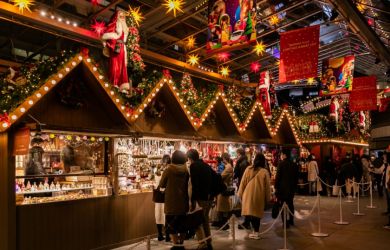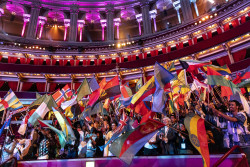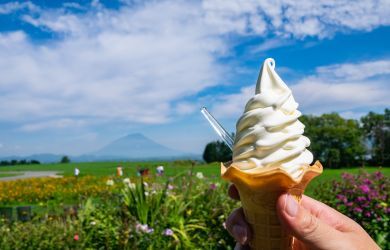
August 6, 2009
Peace of the Action
As Japan commemorates the end of WWII, local activists spread an antiwar message
By Metropolis
Originally published on metropolis.co.jp on August 2009

Tetsuo Shibano (standing, third from right) spreads the word on Shodoshima island in Kagawa Prefecture
August is a month of remembrance for the Japanese. TV stations stream hours of war-related programming, which the public digests as readily as thirst-quenching kakigori. There’s a noticeable split between belligerent nationalists and those of a more dovish nature, as prime ministers visit the war criminal-enshrining Yasukuni Jinja and peaceniks attend conciliatory events to pray for a war-free future.
By September, the country has returned to its daily grind and political apathy, but for a certain band of Japanese people, peace is a year-round vocation. United by a common cause to prevent the mistakes that led the nation to the maelstrom of World War II, these activists—old and young, local and overseas—are using innovative approaches to spread their antiwar message.
Unsurprisingly, it was a nuclear device that proved the catalyst for the nation’s first major antiwar movement. Yet the incident that galvanized Japanese activists wasn’t the 1945 atomic bombings of Hiroshima or Nagasaki, but a US hydrogen bomb test on Bikini Atoll nine years later.
“Japanese fishermen who happened to be near the test site died, and a widespread food scare gripped Japan,” says Mari Yamamoto, author of Grassroots Pacifism in Post-War Japan. “Since then, there’s been a groundswell of suprapartisan antinuclear movements whose influence spreads to many other countries, including groups like the CND (Campaign for Nuclear Disarmament) in Britain and the SANE (Peace Action) in the US.”

Naoko Jin interviews the daughter of a Filipino war survivor
The Bikini incident spawned a massive petition drive that amassed some 30 million signatures calling for a global ban on nuclear testing. The campaign’s success led activists to press the government to rethink such matters as the creation of the Self-Defense Forces and the stationing of US military personnel in the country, notably in Okinawa.
Leftist political parties and large trade union federations led many of Japan’s peace movements in the postwar years, but these groups tended to reflect the hierarchical structure of more mainstream Japanese organizations. Since the Vietnam War era, activist associations have taken on more of a grassroots nature and a more colorful slant.
“Around the time of the beginning of the war on Afghanistan and then the Iraq War, there were peace walks all over Japan,” says Ronni Alexander, an antiwar activist and professor at Kobe University’s Graduate School of International Cooperation Studies.
“One day in Osaka, at a march of about 10,000 people, I skipped out of line to take a photo from a bridge. The old school had their matching name tags and clothing, fists in the air, chanting… The new school wore colorful clothes and carried an odd assortment of signs and placards, and were mostly singing.”
Underscoring peace efforts in Japan is Article 9 of the nation’s Constitution, which denies the state the right to maintain military forces and forbids belligerency in international affairs. A nationwide Asahi Shimbun poll in May revealed that 64 percent of Japanese citizens oppose changing Article 9, compared to just 26 percent in favor of revision. At first glance, these figures are reassuring to those who want to maintain the constitutional status quo, but one elderly firebrand for peace is not about to take Japan’s pacifism for granted.
Tetsuo Shibano, 73, is a founder of the Article 9 Association and actively involved with K9MP, or the Article 9 Message Project. A Japanese Communist Party member and former journalist for the party’s Akahata (Red Flag) newspaper, Shibano grew up in postwar Kyoto, a hotbed of radical activity. He was 14 at the outbreak of the Korean War in 1950, an event that led him to campaign to prevent the revision of Article 9. Since then, he’s written award-winning books on issues ranging from poverty to the nuclear industry.
“At the moment, we can’t directly engage in conflict with other nations, but the government keeps on bringing in laws through the back door to enable the dispatch of troops,” Shibano tells Metropolis. “Should bills revising the Constitution be passed, the SDF, as well as going to places such as Somalia and Afghanistan, will have to do as the Americans say and actually start wars.”
Frail and with a wispy beard, Shibano was diagnosed with stomach cancer about ten years ago, and a debilitating muscle disease makes it a struggle for him to walk. Yet “Jiji,” as he’s affectionately known, still drives the length and breadth of the nation on speaking engagements to promote the merits of the pacifist article.
Recently, however, he feels that time is running out—both for himself and efforts to safeguard Article 9. Shibano tells the story of an Iraqi friend whose trust in Japan was shattered after the country lent its support to the US-led coalition waging war there. “When the SDF went over, we instantly lost the trust of the Iraqi people,” he says. “This is why people like [Japanese aid worker] Nahoko Takato were taken hostage.”
Shibano believes that if the government holds a referendum on Article 9, which could be a possibility sometime in the next couple of years, his fellow citizens will have a momentous decision to make.
“The Constitution was originally imposed on us by the Americans, but if we Japanese elect to keep it, that would be historical because the public will decide this for themselves.”

Festival-goers at a PNWJ-sponsored peace session in Yoyogi Park
While Article 9 was spawned from the ashes of World War II, atrocities committed by the Imperial Japanese Army have led one young woman on a bridge-building exercise between Japan and a former wartime colony.
Naoko Jin’s life changed direction on a monthlong study tour to the Philippines in 2000, when she met a woman whose own life was ruined by the Japanese.
“I met many victims,” Jin says. “One of them said she was meeting a Japanese for the first time and asked me, ‘Why did you come here?’ The Japanese captured her husband in 1942—the year they married—and he never returned. As a Japanese, I wondered if there was anything I could do.”
After returning to Japan, Jin visited a nursing home and listened to the stories of veterans who served in the Philippines. “Many of these men were ordered to commit barbaric acts against the locals and have been suffering tremendously ever since.”
In 2004, Jin established Bridge For Peace, a group that records video testimony of both Japanese war veterans and the Filipinos who suffered at their hands. It holds screenings in both countries to promote mutual understanding and empathy between the former aggressors and victims. Jin visits the Philippines on a regular basis and still actively records the testimony of veterans—about 70 have spoken to the group to date.
Now boasting 12 members, BFP holds regular events, study sessions and cultural exchanges to encourage antiwar sentiment and raise awareness of the pain that lingers on both sides. As part of its fifth anniversary celebrations this year, the group will stage its second textbook project—an exhibition that compares how countries across Asia and the world teach the history of the Pacific War to high school students.
Jin, 31, is an articulate and passionate speaker who is realistic enough to acknowledge that the effect of her activities may be limited, but still sees great worth in them.
“I don’t think what I’m doing is going to change anything, but I hope to increase exchanges between people of different countries and give the elderly men a chance to speak of their feelings before they die,” she says. “I feel the Japanese in my generation are so busy with their lives that they’ve lost the ability to think about what is really important.
“I don’t want people to think Japan is a bad country. It isn’t. I just want people to know what really happened.”
Another Japan-based group uses a more melodious approach to spread its message. Peace Not War Japan is an offshoot of the UK-based organization formed in 2002 to protest the invasion of Afghanistan. The British group began by producing an antiwar CD, and has grown into a collective of students, artists, activists and technicians that pool their musical talent to take their message to a larger audience. The Japanese arm released an album by local artists in 2006, and regularly sets up information booths at gigs and festivals here.
PNWJ’s coordinator, Kimberly Hughes, is an American freelance translator, writer and teacher who has been an activist for many years on both sides of the Pacific.
“I used to be someone who approached peace through demonstrations,” she says. “That’s cool and all, but it gets old and, for me, loses its ability to inspire… I think music has the ability to reach so many people—people who wouldn’t otherwise think themselves political.
The group has succeeded locally thanks in part to its ability to key into local youth culture. “We hooked up with a group called Harukaze, who put on rave parties in Yoyogi Park every Sunday for about ten years. We teamed up with them again this April. They put on the music and we provided the peace speakers. The sakura was in full bloom, we had a blowout, and about 40,000 people came—it was really cool.”
PNWJ is helping plan another hanami event with Harukaze next April and has several live shows coming up, including a showcase called Birth of Peace on August 15 in Shinjuku. The group sells its CD at these events and gives a cut of the proceeds to grassroots peace groups, while at the same time attempting to capture the hearts and minds of raving hedonists.
“We started one peace discussion—there were about four or five of us and no one was listening. They were dancing and drinking, but half an hour later, about 100 people had stopped, were listening intently, and started asking questions.
“I hope peace activism makes a difference,” she adds. “But there is always the feeling of powerlessness. What can you do? How can you make change? How do you get governments to make choices that promote peace, not violence? We combine traditional activism with music in the hope it will inspire more people. If you throw a pebble in the ocean, it will create a ripple effect elsewhere.”
Peace Links
Article 9 Association:
www.9-jo.jp/en/index_en.html
K9MP:
www.k3.dion.ne.jp/~k-9mp/
Bridge for Peace:
www.bridgeforpeace.jp
Peace Not War Japan:
www.pnwj.org
Harukaze (English name: Spring Love):
www.balance-web.com/harukaze/index-e.html
Birth of Peace gig on Aug 15 (supported by PNWJ):
www.myspace.com/birthofpeace







